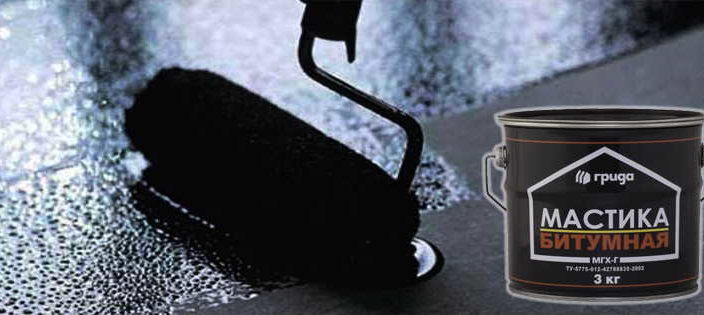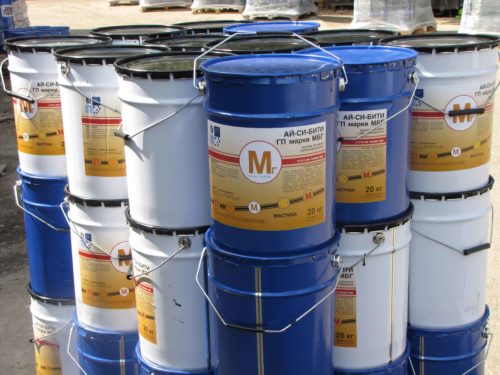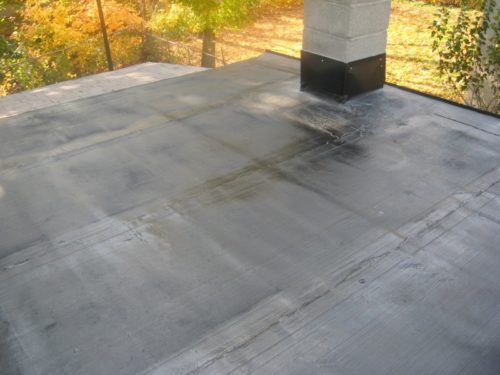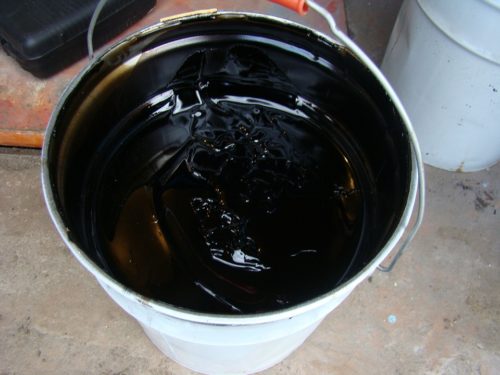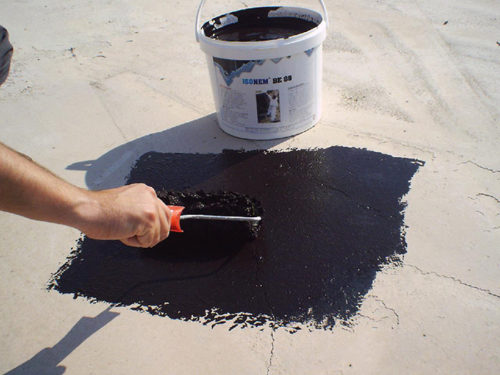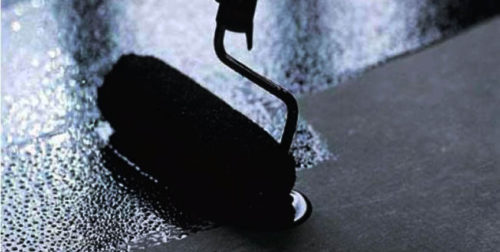In the afternoon and at night, the roof of any buildings are susceptible to serious tests: snowfalls, rains, temperature drops, solar rays and penetrating winds. All these weather phenomena affect the roofing materials: the roof begins to deteriorate and leak. So that this does not happen, pay attention to the new roofing material - bitumen mastic.
Content
Bituminous mastic is widely used in construction as the main roofing material, used for laying and rolled coating, including linoleum and even parquet. But still the main task of this material is to protect the roof of any structure from moisture from entering the placement.
Benefits of bituminous mastic
Mastic - option is economical and not costly, with the help of bitumen mastic, you can overlap the entire area of \u200b\u200bthe roof, without fear that water will survive inside the housing. In the last century, this material was also used, or rather its natural analogue. To block the roof, there was a resin and tar. In nature, you can meet a native bitumen, but it is a rather rare phenomenon.
What is a bitumen mastic is a product obtained by refining oil materials. Various binders are added to the main component: asbestos, mineral wool, quartz, lime and cement, as well as ash. These fillers solidify, forming a dense layer, resistant to temperature fluctuations. Mastic - plastic material, working with it is a pleasure.
The main advantage of this material is affordable price and excellent physico-mechanical properties. It is also worth noting that the mastic when applied to the surface forms a protective film that prevents moisture ingress. There are no joints or seams of roofing material on the surface. If you bought the latter generation mastic, then it can be applied to the roof even without prior preparation. Suppose the roof is wet, the rust manifested in places - it is not necessary to clean and clean it, this material is perfectly lifted even on such a surface without temporary consequences. After some time, the roof covered with bituminous mastic will remain the same as on the first day of application, the material does not swell and does not exfoliate.
Pluses of bituminous mastic:
- the blood coating is performed in a seamless method, which significantly prolongs the life of the roofing surface. In addition, you can apply mastic on the dome, flat roofs, spiers and pitched roofs;
- roof repair can be performed both overhaul and replace a certain area. Bituminous mastic allows you to work in 2 directions: full roofing or carb repair;
- an old coating can be dismantled;
- the roof covered with bitumen mastic is much easier than all other rolled materials;
- high strength of material: no cracks, shrinkage and deformation after drying will not.
Disadvantages of bitumen mastic for roof:
- Work can be performed only in clear weather. Therefore, dependence on weather conditions does not allow repair of the roof when it is necessary.
- During the application of the material it is difficult to monitor the thickness of the layer. Therefore, the material consumption increases, especially if the roof is uneven.
- As for the processing of inclined and uneven surfaces, the task is complicated, because the consumption of material increases. And if I want to save, then you will have to pre-carefully prepare the surface.
Views of bitumen mastik
Bituminous mastic is divided into such types:
- mastic cold way - is a homogeneous mass, which is immediately ready for application. To make a lot of thinner, add special solutions. If the batch is done - it must be applied immediately, because the sealant to quickly grasp. Some types of cold mastics require preheating to a temperature (generally not higher than 40 degrees);
- hot mastic - the roofing material prior to use is required to be heated to a temperature of 180 degrees (bottom point 150 degrees). Apply the mass in hot form, so while the need to observe safety precautions. After cooling the sealant takes the form of a roof;
- water-based material - the most versatile and viable option, because the material is classified as "environmentally friendly materials." Use mastic easy, it does not need to be heated, mastic cost - quite affordable for each customer.
How to choose a bitumen mastic? It should be understood that many types of material, but to find the right, it is necessary to take into account the structure of the roof and its features. In accordance with this, study mastics characteristics:
- bitumen latex with addition - in the composition are present synthetic and natural, mineral fillers, and additives. Main components of this bitumen and latex, as fillers are: mineral wool, powders and asbestos. Use this putty to repair roofs as an independent coating, and for sticking roofing roll material;
- hot mastic - requires heating up to 150 degrees. Combined with any material, which is very beneficial for the coating of different roofs.
Bituminous mastics. Characteristic:
- mastic durable;
- material is consumed economically, the cost is low;
- weight - minimum;
- high resistance to aggressive environments;
- tinting can be done in any color;
- applied quickly and easily;
- it does not require the joining of seams, because they do not exist;
- good viscosity material and also elasticity.
Allocate classification of roofing material:
- By appointment: for roofing, to get rid of corrosion, waterproofing asphalt pavement.
- According to the composition: two-component, one component.
- Type of binder: polymer, latex, a mixture of bitumen with polymers and bitumen latex rubber materials.
- By properties: with the addition of water, solvents, organic components.
The most popular option is a bitumen mastic for roofing, as well as a latex mixture with a bitumen for roofing.
The composition of bituminous mastic
The roofing mastic includes binding components, polymers, mineral fillers. Heating temperature - within 150 degrees. The material is well compatible with any building materials.
Norms for GOST hot bitumen mastic:
- uniform structure without additional impurities;
- high heat resistance (up to 70 degrees);
- environmentally friendly, without excretion of harmful toxins;
- fluid, if mastic is warm - it should be easily spread over the roof;
- good adhesion with any materials, as well as drying, a single monolithic canvas without cracks should be created.
The composition may contain additives, mineral fillers (powders, minvat, asbestos, cement), binding components - mandatory. This is bitumen and latex.
Sphere using bitumen mastic
Bituminous mastic is the best waterproofing material, the cost of which is low, and the quality - remains at the proper level. If you add certain additives (mineral wool, solvents, other mincontrols), then the material will be called "bitumen mastic".
Mastic plastic, dense and durable, so used in different fields of activity, namely:
- to protect the roofs in order to improve waterproofing properties;
- protection against atmospheric precipitation of balconies and loggias;
- protection against moisture of open pools and artificial reservoirs;
- in order to increase the waterproofing of pipelines, as well as floors in the premises.
Waterproofing of bituminous mastic
If cold mastic is used in the work, then you first need to mix the roofing material. Before starting work, it will not be superfluous with the instruction, because some manufacturers are recommended to add solvents into mastic, for liquefaction. You can work with this material when the temperature on the street does not fall lower than +15 degrees. It is allowed to cover the roof with cold bitumen mastic at low temperatures (from +5 degrees), only then the material must be heated to a temperature of +50 degrees) to improve coating adhesion.
Procedure for work:
- Preparation of the surface: Clear from dust, dirt, remove the old coating (if deformed).
- If you work on a porous surface, then additionally the roof will have to be treated with special compositions (for example, to apply a bitumen primer).
- The roof must be addicted if this is indicated in the instructions.
- The mastic was stirred well, you can pour directly from the bucket to the surface and a wooden mop to dissolve that approximately layer of roofing material was the same everywhere.
- After drying the first layer, you can walk on the roof to mark the most problematic places. They need to be additionally covered with a layer of bitumen mastic (applied with a spatula).
- Application of mastic is performed in several stages. But you can apply 1 or 2 layers of material, but so that the total thickness of the coating does not exceed 3 mm. Each layer must dry during the day. Approximately 3-5 days are given to work.
- Works are performed in dry and mad weather.
Applying bitumen mastic. Video:

